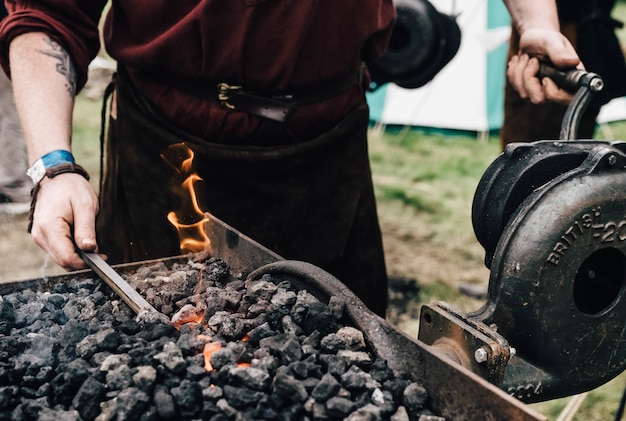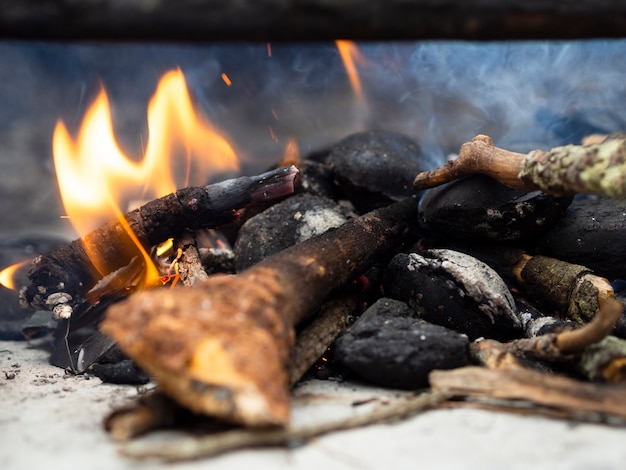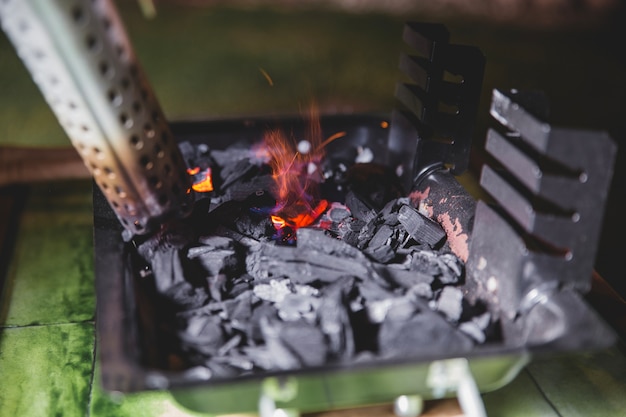What You Should Do to Put Out Coal in a BBQ?
The Importance of Properly Extinguishing Coal in a BBQ
When it comes to barbecuing, safety should always be a top priority. Ensuring that you properly extinguish the coal in your BBQ is not only important for preventing accidental fires but also for the preservation of the environment. In this article, we will discuss the steps you should take to safely put out coal in a BBQ.
Step-by-Step Guide to Extinguishing Coal in a BBQ
Follow these steps to ensure that the coal in your BBQ is completely extinguished:
- Close the Air Vents: Before attempting to extinguish the coal, close all the air vents on your BBQ. This will cut off the oxygen supply and help slow down the burning process.
- Leave the Lid Open: Keeping the lid open will allow heat and smoke to escape, preventing any potential buildup of pressure inside the BBQ.
- Wait for the Flames to Die Down: Allow the flames to die down naturally. It’s important to resist the urge to pour water on the coals immediately, as this can cause a sudden release of steam and potentially burn you.
- Spread Out the Coals: Using a long-handled tool, such as tongs or a poker, spread out the coals evenly to increase the surface area and speed up the cooling process.
- Let the Coals Cool: Wait for the coals to cool down completely. This can take anywhere from several hours to overnight, depending on the size and type of coals used.
- Dispose of the Coal Safely: Once the coals are cool to the touch, carefully remove them from the BBQ and transfer them to a metal container designated for ash disposal. Never dispose of hot or warm coals in a plastic bin or near combustible materials.
- Clean and Store: After the coal has been properly extinguished and disposed of, clean your BBQ grates and surfaces to remove any remaining ash or debris. Store your BBQ in a safe and secure location, away from flammable objects.
Tips for Safe Coal Disposal
Proper coal disposal is crucial to preventing fire hazards. Here are a few tips to ensure safe disposal:
- Use a Metal Ash Container: Invest in a metal container specifically designed for ash disposal. This will prevent any accidental fires caused by hot ashes coming into contact with other materials.
- Keep the Container Outside: Store the ash container outside, away from any structures or flammable materials. Ensure that the container is placed on a non-combustible surface such as concrete or stone.
- Wait for Complete Cooling: Only dispose of the coals once they are completely cooled down. Hot or warm coals can still pose a fire risk if not handled properly.
- Double-Check Before Disposal: Before discarding the ashes, always double-check to make sure there are no remaining embers or hot spots.
Remember: Never dispose of hot or warm coals in a plastic bin or near flammable materials. Always prioritize safety and take the necessary precautions to prevent accidental fires.
Should I use water to put out charcoal?
When it comes to extinguishing charcoal, using water may not always be the best approach. While water can help cool down the embers and ashes, it can also lead to other issues such as excess smoke or even potential damage to your grill or barbecue.
The drawbacks of using water
Pouring water directly onto hot charcoal can cause a sudden release of steam, resulting in a burst of steam and smoke. This can not only be hazardous but also create an unpleasant experience for those around you. Additionally, excessive water can make the charcoal difficult to light again for future use.
Safer alternatives
If you’re looking for a safer method to extinguish your charcoal, consider the following options:
- Allow natural cooling: Give the charcoal ample time to cool down on its own. Avoid spreading hot coals or ashes, and keep children and pets away from the area until it has cooled completely.
- Use sand or dirt: Covering the charcoal with sand or dirt can help smother the flames and prevent any potential reignition. Ensure you have enough material to fully cover the charcoal.
- Close the vents: If you’re using a grill with adjustable vents, close them to restrict the oxygen flow. This will gradually snuff out the fire and prolong the cooling process.
Using water is not recommended as the primary method for extinguishing charcoal. It’s best to let the coals cool naturally or use alternative methods such as sand or closing vents to ensure a safe and controlled process.
By being mindful of the potential hazards and using safer methods, you can enjoy your charcoal grilling experience while prioritizing safety and convenience.
Do you just let charcoal burn out?
When it comes to grilling, many people wonder what to do with the leftover charcoal once they’re finished cooking. Should they let it burn out completely or can it be reused for another BBQ session? Let’s find out!
Letting charcoal burn out
One option is to simply let the charcoal burn out on its own. This is a convenient method as it requires minimal effort. However, there are a few things to consider.
Keep in mind that letting charcoal burn until it extinguishes naturally can take several hours. It’s important to ensure the grill is placed in a safe area away from any flammable materials.
Reusing charcoal
If you have good quality charcoal that hasn’t been excessively used, it’s possible to reuse it for future grilling sessions. Follow these steps:
- Clean the grill grates to remove any food residue or ash.
- Close the grill vents to limit oxygen flow and extinguish the remaining flames.
- Once cooled, carefully collect the leftover charcoal pieces and store them in a dry place.
- Next time you want to grill, add fresh charcoal and mix it with the reusable pieces for an efficient burn.
When to dispose of charcoal
Eventually, charcoal will become too ashed or damp to use effectively. If you notice excessive ash buildup or a significant decrease in performance, it may be time to replace your charcoal. Charcoal can typically be disposed of in your regular household waste, but check your local regulations to ensure proper disposal.
In conclusion, whether you choose to let charcoal burn out or reuse it depends on personal preference and the quality of the charcoal. By following proper safety precautions and storing reusable charcoal correctly, you can make the most out of your grilling experience!
How Long Does Coal Last in a BBQ?
When it comes to barbecuing, coal is a popular choice among many grill masters in the UK. It provides that distinct smoky flavor and a consistent heat source for cooking delicious meals. But how long does coal actually last in a BBQ? Let’s find out!
The Type of Coal:
There are different types of coal available for barbecuing, such as charcoal briquettes and lump charcoal. The type of coal you choose can affect how long it lasts in your BBQ. Charcoal briquettes usually burn longer and at a more consistent temperature compared to lump charcoal.
Burning Time:
The burning time of coal depends on several factors, including the amount of coal used, airflow, and the type of BBQ you have. On average, a standard bag of charcoal briquettes can last around 3-4 hours for grilling purposes. Lump charcoal, which is more natural and burns hotter, may last slightly less time.
Tips to Extend Burning Time:
- Use a chimney starter to ensure even and efficient burning.
- Arrange the coals in a two-zone setup, with one side having more coals for direct heat and the other for indirect heat.
- Cover the grill when not in use to conserve heat and reduce airflow.
- Consider adding a few unlit coals to the grill during cooking to extend the burning time.
Factors Affecting Burn Time:
Several factors can impact how long coal lasts in a BBQ:
- Weather conditions: Windy conditions can accelerate coal burn, while cool temperatures may slow it down.
- Grill size and design: The size and design of your grill can affect coal burn time. Smaller grills tend to use less coal and may require replenishing more frequently.
- Cooking method: Direct grilling, where food is placed directly over the coals, may require more coal compared to indirect grilling methods.
Note: It’s important to follow the manufacturer’s instructions and safety guidelines when using coal in your BBQ. Always ensure proper ventilation and never leave a lit BBQ unattended.
In conclusion, the burning time of coal in a BBQ can vary depending on several factors, but on average, a standard bag of charcoal briquettes can last around 3-4 hours for grilling. By using proper techniques and considering various factors, you can extend the burning time and make the most out of your coal for a delicious BBQ experience!
Can you put too much coal on a BBQ?
When it comes to firing up the barbecue, many people wonder if they can put too much coal on the grill. While it may be tempting to load up the barbecue with coal to ensure a longer and hotter burn, it’s important to strike the right balance for the best cooking experience.
Quantity Matters
The quantity of coal you use on your BBQ depends on several factors, such as the size of your grill, the type of food you’re cooking, and the desired cooking time. Putting too much coal on the grill can result in excessive heat, which may cause your food to cook too quickly or burn on the outside while remaining undercooked inside.
Proper Airflow
One key factor to consider when adding charcoal to your BBQ is airflow. Charcoal needs oxygen to burn properly and produce heat. If you pile too much coal on the grill, it might restrict the airflow, leading to poor combustion and uneven cooking. It’s essential to allow for proper ventilation by ensuring there is enough space between the coals.
Getting it Just Right
For most standard-sized charcoal grills, a good starting point is to create a single-layer of coals. This allows for efficient heat distribution and ensures that the coals burn evenly. As you gain experience, you can experiment with adjusting the amount of coal depending on the specific cooking requirements.
Remember:
It’s better to start with fewer coals and add more if needed than to overload the grill and risk ruining your food.
If you find that you need to add more coals during the cooking process, do so gradually. Add a few at a time to avoid drastic temperature changes that may affect your cooking. Using a chimney starter can also help you preheat additional coals before adding them to the grill.
Tip:
Consider using a direct and indirect grilling method by stacking the coals on one side of the grill only. This way, you can have both direct and indirect heat zones, allowing for more control over your cooking.
In summary, while it may be tempting to load up your barbecue with lots of coal, it’s important to find the right balance for optimal cooking results. Avoid overcrowding the grill and ensure proper airflow to achieve evenly cooked and delicious food every time you fire up your BBQ.
How do you make charcoal fuel?
Charcoal fuel is a popular alternative to traditional fossil fuels due to its eco-friendly and renewable nature. It is commonly used for cooking, heating, and various industrial processes. Making charcoal fuel involves a simple process of converting wood into charcoal through a controlled burning process called carbonization.
1. Selecting the right wood
To create high-quality charcoal fuel, it is important to select the right type of wood. Hardwoods such as oak, maple, or hickory are preferred due to their higher density and carbon content. These woods provide better fuel efficiency and a longer burn time.
2. Carbonization process
The carbonization process involves heating the selected wood in an oxygen-limited environment. This can be achieved through methods like traditional kilns, retorts, or modern industrial pyrolysis techniques. The goal is to remove the moisture and volatile compounds from the wood, leaving behind pure carbon.
Quote:
“The key to making good charcoal fuel lies in controlling the temperature and oxygen levels during the carbonization process.”
3. Stacking the wood
In the carbonization process, the wood should be stacked in a way that allows for proper airflow while limiting oxygen supply. A pyramid or dome-shaped structure is commonly used, ensuring that combustion is minimized. This helps in producing charcoal with consistent quality.
4. Ignition and monitoring
Once the wood is stacked, it should be ignited from the bottom and allowed to burn slowly. It is important to monitor the temperature and adjust the airflow accordingly to maintain an oxygen-limited environment. This can be done by using dampers or controlling the ventilation openings.
5. Cooling and collection
After the wood has burned for an adequate time (usually several hours), the charcoal should be left to cool down in the closed system. Once cooled, the charcoal can be collected and crushed into smaller pieces, ready to be used as fuel.
Using charcoal fuel not only helps reduce carbon emissions but also provides a more sustainable and renewable energy source. So, why not give it a try and experiment with making your own charcoal fuel at home?
Tip: To enhance the efficiency of your charcoal fuel, consider using a charcoal stove or a specialized charcoal grill.


